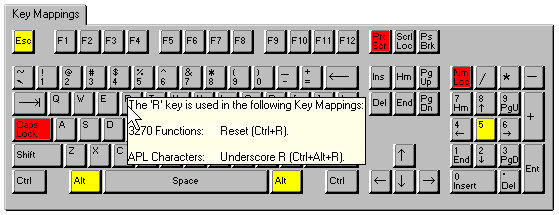 Using the Display Interface
Using the Display Interface Using the Display Interface
Using the Display InterfaceBlueZone keys by default are mapped to a standard BlueZone keyboard map. If you want to change a key mapping, follow this procedure.
From the BlueZone MenuBar
select Options: Keyboard or press
the Keyboard icon ![]() found on the ToolBar.
The Key Mappings property sheet will display
a bitmap image of a keyboard.
found on the ToolBar.
The Key Mappings property sheet will display
a bitmap image of a keyboard.
Before attempting to map a key, it's a good idea to check and see what that key is currently mapped to.
To find out, hold the mouse pointer over a particular key on the keyboard image and left click.
For example, if you wanted to know what the R key is mapped to, place the mouse pointer over the R key and left click as shown in the following illustration.

BlueZone will create a pop-up window detailing all the key mappings that are associated with the R key.
This procedure assumes that you are mapping a Standard 101/102 -Key keyboard.
Select a group from the Functions Group List Box.
Select a function from the Functions List Box. Any existing key mappings for that function will appear in the Key Mappings List Box. If there are no keys currently mapped to this function, BlueZone will display: <No Keys Mapped to Function>.
Click the New button. If there are existing key mappings, BlueZone will create a new blank highlight bar in the Key Mappings List Box.
With your mouse pointer, go to the keyboard bitmap and click the key that you want to associate with the function that you chose in step 2. The name of the key will appear in the Key Mappings List Box.
Click the OK button. The selected function will now be mapped to the new key. Any other keys that are mapped to this function will also be displayed in the Key Mappings List Box..
Select a group from the Functions Group List Box.
Select a function from the Functions List Box. Any existing key mappings for that function will appear in the Key Mappings List Box.
With your mouse pointer, highlight the Key Mapping in the Key Mappings List Box you wish to edit.
Click the Edit button.
With your mouse pointer, go to the keyboard bitmap and click the new key that you want to associate with the function that you chose in step 2. The highlighted key will change to the key that you just selected.
Click the OK button. The Function will now be mapped to the new key.
 NOTE If
you wish to map a function to a multiple key sequence, you must choose
the active key first, then choose the Ctrl or Alt key last. For
example, if you wanted to map the New
Line function to the keypad enter key, you would click the keypad
enter key first, then click the Ctrl key last.
NOTE If
you wish to map a function to a multiple key sequence, you must choose
the active key first, then choose the Ctrl or Alt key last. For
example, if you wanted to map the New
Line function to the keypad enter key, you would click the keypad
enter key first, then click the Ctrl key last.
Both the ALT and CTRL keys have a dual modes. They can be mapped to a function by themselves, or they can be used in combination with other keys.
For Example, if you want to map the 3270 function "Print Screen" to CTRL+P, click the right CTRL key which will display as: Right Ctrl. Then click the right CTRL key again and it will change to Ctrl+ , then click the P key which will result in Ctrl+P.
The 3270 Function Overstrike Sequence allows a non-ASCII character in the EBCDIC character set (such as è) to be entered from the keyboard. Overstrike causes the emulation to enter overstrike mode, after which two ANSI characters (such as e and `) are typed to represent the desired character. If the two characters represent a valid combination, the resulting EBCDIC character is entered into the device buffer. An uncompleted overstrike can be canceled with the Reset key.